#mississippistudies
Video
vimeo
The Shape of a Practice
HKW
2020, Oct 26, Mon — 2020, Nov 30, Mon
I was involved in organizing elements of this seminar, including an exhibition based around our work on and about the Mississippi River, entitled The Current.
The Anthropocene is often perceived as either a planetary-scale concept or an extremely local concern. Yet neither of these accounts considers that the global and the local are deeply interconnected. So how can diverse local research, struggles and practices be related to one another in order to establish a mutual ground of experience and for action within the geological age of humans?
Over the course of a week, The Shape of a Practice brings together over 100 researchers, scientists, artists and activists to share their fields and methods of work on everything from water pollution and disaster management to an interrogation of the new geological era’s colonial histories. In an interactive virtual environment, specifically designed for the event, as well as on-site at HKW, distinct questions, strategies and forms of action will be linked to form a topology of the Anthropocene.
0 notes
Text
AN AESTHETICS OF DISPLACEMENT

(Written as an introduction to the Anthropocene Film Residency. Read more about the project on the Anthropocene Curriculum website.)
1
Looking down on St. Anthony Falls from the walls of the lock and dam infrastructure, one can marvel at this feat of technical engineering. The river runs over an artificial concrete platform creating the Falls. The lock with its giant metal gates holds back millions of gallons of water. It is a triumph of modern engineering and architecture, built for commercial river traffic in pursuit of profit and progress.
The lock is now closed; its gates welded shut. Today, when standing atop the lock and dam, one cannot help but reflect critically on its existence as a monument to a different time, a pre-climate change past. During a spring season that has witnessed extensive flooding up and down the Mississippi River, one cannot help but worry about its inadequacy and anticipate failure.
2
In its current obsolescence, the aged lock and dam infrastructure is a monument to a dark history. Built into its hard structures is the historical legacy of a technic for the displacement of material, non-humans, and human communities. Its presence speaks to the violence of forced movement and dislocation. In a material sense, a dam is engineered to displace water, to hold it back and redirect its flow. The concrete walls and embankments are fortified barriers for keeping nature at bay. The dam is a military technology as well. It shares a history with the berm, which acts as a human breakwater, a defensive technology for the displacement and separation of groups of people.
3
Over the past six months, four artists have developed new short films inspired by our field station’s approach to Mississippi. An Anthropocene River. They were selected because of pre-existing practices that involved a critical envisioning of the Mississippi River and/or an assessment of the environmental impacts of human activities on bodies of water. A common theme in the artists’ work is an aesthetics of displacement. Andrea Carlson’s site-specific short film, The Uncompromising Hand (2017), revisits Spirit Island, a sacred site to multiple Indigenous communities that was once in the Mississippi River near the current lock and dam. Tia-Simone Gardner’s Reading the River: Yemaya and Oshun (2018) is an experimental documentary set in port cities along the Lower Mississippi River and reflects on Blackness in relation to geography, architecture, and a feminist practice of unsettling how we think and know place. Jenny Schmid’s prints, including The Last Tree Huggers (2017) and Momento Mare (2017) feature monstrous creatures who make an uneasy home in the environmental ruin of a disastrous present. John Kim’s piece, Dam, Lock, Groyne: The Temporal Architecture of the Mississippi River (2019) is a reflection on the hard structures and earthworks found along the entire length of the Mississippi River that displace water, people, and non-human species. Each artist introduces their new work in the pages that follow.
Read more about the project on the Anthropocene Curriculum website.
0 notes
Text
vimeo
Instagram story of the first half of the Anthropocene Curriculum. From @anthroriver
0 notes
Photo

Mississippi Studies
We propose an ACM Planning Meeting on Mississippi Studies to build faculty interest and develop infrastructure on Mississippi Studies, a new research initiative to encourage intercollegiate collaboration on publicly engaged projects that center on the Mississippi River watershed and its inhabitants. The goal of Mississippi Studies is to re-imagine the river and its tributaries as a coherent cultural and research corridor and foster new ways of thinking about its shared environment, its heritage, and its rich role in the history of the United States. Mississippi Studies will have a direct role in faculty career enhancement by creating off-campus opportunities for faculty to work with colleagues at other ACM colleges and cultural and scientific institutions in this region.
The long-term objective of the Mississippi Studies initiative is the creation of the Mississippi River Research Barge, a floating cultural and scientific research platform that travels the length of the river promoting translocal collaborations. The vision is to establish a research environment that encourages faculty working in close proximity to each other to integrate scientific research with the arts, humanities and social sciences. Participants of the ACM Planning Meeting on Mississippi Studies will conceptualize this project in anticipation of its realization.
More info: http://mississippistudies.org/
0 notes